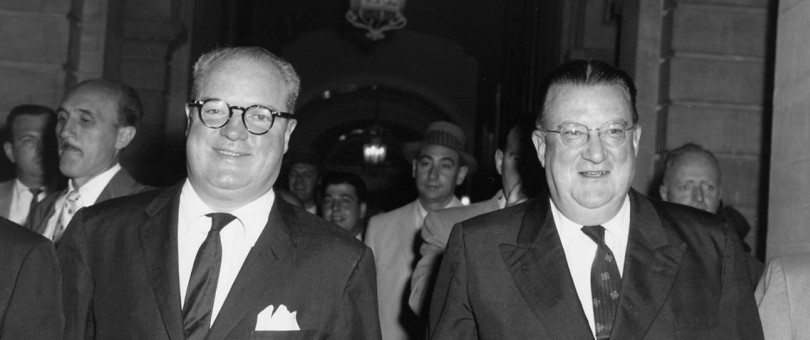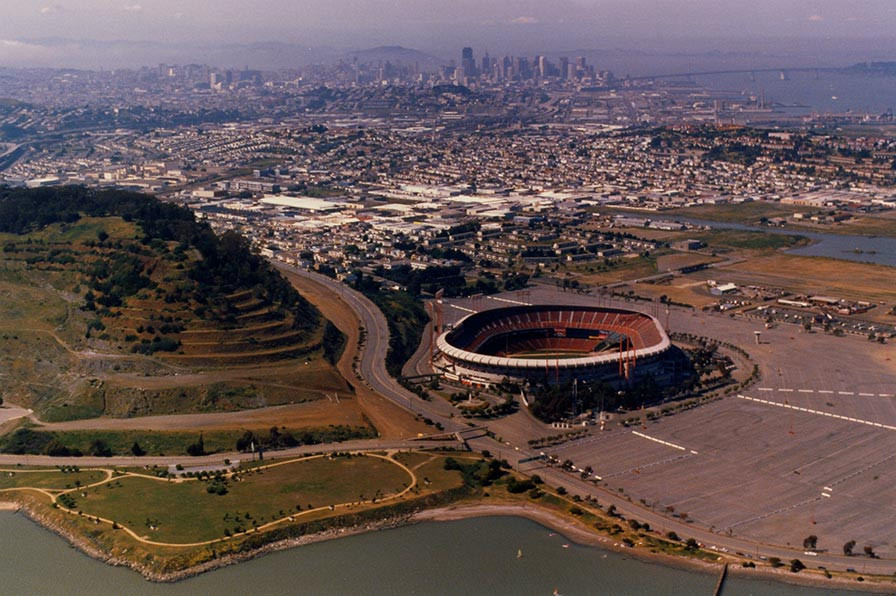
Horace Stoneham, owner of the New York Giants (left) and Dodger President Walter O’Malley display wide grins en route to press conference following their one hour and 20-minute conference with the New York Mayor Robert Wagner on June 4, 1957. The two Major League Baseball team owners told newsmen that they informed the mayor that they had no definite obligations to move to the west coast – and no obligations to stay in New York. In center of photo wearing a fedora is sportscaster Howard Cosell.
O’Malley Family Earns Two Saves of the San Francisco Giants
By Brent Shyer
In 1957, nearing the end of his unprecedented 10-year effort to keep the Dodgers in Brooklyn, Dodger President Walter O’Malley suggested to New York Giants’ owner Horace Stoneham the possibility of joining forces on the West Coast starting in 1958 keeping the longtime and successful rivalry alive.
Stoneham had made up his mind to relocate the Giants from the Polo Grounds to Minneapolis where their minor league Millers team was popular and had the territorial rights. But O’Malley, still attempting to remain in Brooklyn and privately build a domed stadium for the Dodgers at the intersection of Atlantic and Flatbush Avenues, suggested to Stoneham to consider San Francisco. O’Malley even participated in a May 10, 1957 meeting with Stoneham and San Francisco Mayor George Christopher at the Hotel Lexington in New York, where an outline for a Giants’ agreement was begun. National League owners stipulated that if the Giants and Dodgers decided to move westward, it would have to be in tandem to make sense for the other clubs travel schedule-wise.
On August 19, 1957, the Giants announced that they were leaving New York to move to San Francisco for the 1958 season. After exhausting all options in Brooklyn, the Dodgers officially notified the National League on October 8, 1957 of their intention to shift their franchise to Los Angeles for the 1958 season, joining the Giants and expanding Major League Baseball’s borders westward.
The rivalry during the O’Malley era continued to thrive as expected – the Dodgers winning World Championships in 1959, 1963, 1965, 1981, and 1988 and N.L. Pennants in 1966, 1974, 1977 and 1978. The Giants won the 1962 N.L. Pennant (preventing the Dodgers from winning it in a three-game playoff series) and lost in the 1989 World Series.
What is not as well remembered today is that O’Malley and his son Peter were important allies to keep the Giants in San Francisco. On two occasions – in 1972 and 1993 – it appeared that the Giants would pull up stakes to relocate the team. But, with resistance from the O’Malley family in the National League, neither of those efforts to move happened.
In 1976, with dipping attendance, unexceptional play after 1971, and windy and cold conditions at municipally-owned Candlestick Park, Stoneham believed it was time to place the Giants on the market after four decades as owner. Across the Bay, the Oakland Athletics were dominating headlines, having won three consecutive World Series (1972-1974) while the Giants were struggling. But, trying to find local ownership became a challenge. Labatt Breweries of Canada wanted to purchase the team from Stoneham and move the Giants to Toronto. Logos were created for the “Toronto Giants” and negotiations pushed forward as if the move would proceed. Walter and Peter O’Malley were intently discussing the situation with their fellow owners to keep the Giants anchored in San Francisco.

1960 — 1999 CANDLESTICK PARK, San Francisco, San Francisco Giants
Barry Howe Photography Copyright © 1992
Associated Press even ran this story: SAN FRANCISCO. Jan. 9 (AP) — The San Francisco Giants have been sold for $13.25 million and will be moved to Toronto for the 1976 season if the sale is approved by nine of the 11 other National League teams, the Giants announced today.New York Times, January 10, 1976, Page 38
However, the potential move was stymied. George Moscone was elected Mayor of San Francisco just before the announcement was to be made that the Giants were relocating. He filed an injunction to prevent the sale. With the courts granting an injunction, Moscone sought a locally-based owner.
San Francisco businessman Bob Lurie became that savior, purchasing the Giants for $8 million, well under the $13-plus million that Labatt’s had offered. Initially, Lurie formed an equal partnership with former Washington and Texas owner Bob Short, but National League ownership put a requirement that Short would not be a majority owner, due to his residing outside of San Francisco, and Lurie would attend meetings and be the voting owner at meetings. Short rejected the league’s condition and withdrew from the partnership to purchase with Lurie. That left Lurie to scramble and finally he partnered with Bud Herseth of Arizona to purchase the Giants, Lurie becoming the owner with controlling interest at 51 percent.
Before the 1976 season, Peter O’Malley said the Dodgers were optimistic despite the loss of pitcher Andy Messersmith to free agency through the arbitration process. In addition, keeping the Giants in San Francisco was another reason for a cheerful outlook. O’Malley told Gordon Verrell of The Sporting News, “When the Giants’ situation was resolved, it was a big plus. Maybe our luck is starting to get a little better. Toronto is a fine town and all, but it would have been awfully tough on us travel wise, schedule wise, rival wise, just about everything, if they’d have moved. And then, out of nowhere, Bob Lurie comes up with the man to keep the Giants in San Francisco. That might have been the first sign.”Gordon Verrell, The Sporting News, April 3, 1976
Lurie remained owner into the 1990s, but aware that a downtown ballpark would be the future of the Giants, not the often cold, foggy and windy conditions at Candlestick Park. Four referendums for a publicly-financed stadium were rejected by voters (twice in San Francisco and twice in San Jose), despite the Giants’ willingness to fund half of such a project. In 1992, Lurie was ready to sell the Giants. That’s when investors from Tampa Bay, Florida and the City of St. Petersburg made a pitch to land the Giants and a memorandum of agreement had been reached with Lurie to sell.
Then Dodger President Peter O’Malley led efforts to keep the Giants in San Francisco, largely because the rivalry was a fixture for fans in both Los Angeles and the Bay Area. With O’Malley’s voice, he convinced enough National League owners to oppose the St. Petersburg—Tampa Bay’s $115 million bid on a 9-4 vote on November 10, 1992 in Scottsdale, Arizona. At the same time, Peter Magowan of Safeway supermarkets rallied to lead a group to purchase the Giants from Lurie for $100 million. Magowan vowed to keep the Giants in San Francisco.
“More and more clubs realize that San Francisco is the place for the Giants,” said O’Malley. “More and more are impressed with the Magowan group.”Ross Newhan, Los Angeles Times, November 9, 1992
On September 15, 1992, Larry Stone of the Daily Breeze wrote: “In San Francisco’s quest to retain the Giants, the city has an advocate, a potentially powerful one, in Dodgers owner Peter O’Malley. O’Malley says he prefers the team sought by St. Petersburg remain in San Francisco and that he is actively working to make it happen.”
O’Malley was quoted on October 14, 1992: “The news that an all-San Francisco group has made a bona fide offer to buy the Giants is very encouraging. I know some of the individuals in the group and they are all first-class citizens. The picture for the Giants remaining in San Francisco is much brighter today.”Michael Sandalow, San Francisco Chronicle, October 14, 1992
Tim Keown wrote in the San Francisco Chronicle, ”Most of the (Giant) players said they realized the tide had changed two weeks ago when Dodgers owner Peter O’Malley began lobbying heavily in favor of San Francisco’s effort (to retain the team).”Tim Keown, San Francisco Chronicle, November 11, 1992
The Magowan group did receive approval to purchase the Giants, while Tampa Bay would receive an American League expansion franchise in March, 1995 and began play in 1998.
Michael Crockett of the Giants Alliance said: “I have hated the Dodgers my entire life. But I am greatly indebted to Peter O’Malley. I will root against the Dodgers, but I have to admire their owner.” Carl Nolte, San Francisco Chronicle, November 11, 1992
Bruce Jenkins of the San Francisco Chronicle wrote of appreciation of Peter O’Malley for his efforts to have the Giants remain in San Francisco. “Special Thanks: To Bill White, Peter O’Malley and other hidden saviors of the Giants.”Bruce Jenkins, San Francisco Chronicle, October 6, 1993 In a letter to the editor of the San Francisco Chronicle, a fan writes, “This is a franchise that was just one Peter O’Malley away from being in Tampa Bay because of poor attendance.” Letter to the Editor, San Francisco Chronicle, January 1, 1994
In 2007, San Francisco Giants Executive Vice President Larry Baer recalled: “When San Francisco considered moving to St. Petersburg (Fla.) in 1993, Peter O’Malley was the driving force behind keeping the Giants in San Francisco.”Mike DiGiovanna, Los Angeles Times, July 24, 2007 Baer told mlb.com in 2011, “It’s very important that the Giants-Dodgers rivalry on the field thrives. For me, it goes back to Peter O’Malley. We always had a great relationship with him, and in 1992, he helped our drive to save the club (to remain in San Francisco and not re-locate to Florida).”Ken Gurnick, mlb.com, November 17, 2011
Dan Hurby of the San Jose Mercury News wrote: “A Dodger, yeah, a hated Dodger, had led the way in saving the Giants for San Francisco. Dodgers President Peter O’Malley was a stalwart in helping organize the 9-4 vote that sabotaged the move to Florida….”So what do the Giants fans do to thank Peter O’Malley? I suggest a letter of thanks, to be signed by thousands of fans next spring as they visit Candlestick Park and sent to O’Malley for ‘saving our Giants.’ You grit your teeth, bite your lip, and sign, sign, sign….What is important now is the rivalry lives. And that is thanks, in no small part (swallow hard, you Giants red-hots), to the Dodgers.”Dan Hurby, San Jose Mercury News, November 12, 1992
O’Malley said in 1993: “I get about one letter a week (from San Francisco) and there used to be more, thanking me for the role I played. One bar owner even sent me a case of steam beer.”Mal Florence, Los Angeles Times, March 14, 1993

